#Iberian Varieties
Explore tagged Tumblr posts
Text
Past Caso
My favorite wine from this producer, and this bottle is feeling a bit tired. Didn’t see that coming from my last visit, and perhaps a decade is pushing it a bit. It’s still gorgeous, and not by any means drain-food, I will continue drinking this wine tonight and enjoy each moment, though through VARY tertiaried lenses. Still dark, impenetrable ruby with rather little brick, just smelling and…

View On WordPress
#Adelaida District#Best wine reviews#Central Coast Critic#Glenrose Vineyard#Iberian Varieties#Paso Robles#Per caso#Per Caso Iberian Blend#Per Caso Winery#soif#Soif Wine Blog#Souzao#Stephen McConnell#Stephen McConnell Wine Blog#Steve McConnell#Steve McConnell Wine Blog#Tinto Cao#Touringa Nacional#wine1percent
0 notes
Text
Theriotype List
So, to start out, for context, I think we've all seen a skeptic comment about how all therians are only "cool" animals. I personally have always enjoyed keeping up with those with "rarer" theriotypes and even using them as examples when these kinds of arguments are brought up, so I've decided to do a little bit of a personal project, that being creating a huge list of the wide variety within the therian community. Below is the list I've created so far, sorted by general species, then adding in subspecies/breeds, all in alphabetical order.
Please keep in mind and understand that for now, I am only putting Earthen animals on this list, mainly so I and the post can keep up, because there's a LOT here already and I know there are hundreds more out there. Maybe in the future I'll make another list with mythical/fictional/etc. kintypes, or someone else can do that for me, you have my full permission, just let me know, but for now, just Earthen animals.
This list does, of course, need more entries though. If you have a theriotype that you don't see on this list, please comment or reblog and let me know so I can add it! You can follow and find it with the tag "foxskys theriotype list".
Adder - European Agouti Alpaca Ankylosaurus Anteater Argentavis Armadillo - Three-banded Axolotl Badger - American - European - Honey - Japanese - Sunda Stink Bat - Evening - Flying Fox - Vampire Bear - Black - Brown - Polar Bee - Bumble - Honey Beetle - Dor - Stag Binturong Bison - American Bonobo Butterfly - Buckeye Caracal Cat, Domestic - Bombay - Himalayan - Japanese Bobtail - Lykoi - Maine Coon - Oriental - Ragdoll - Shorthair - Turkish Van Centipede - Amazonian Giant - Japanese Giant - Red-headed Cheetah Chickadee Chimpanzee Chipmunk - Eastern Cicada - White Ghost Coatimundi - White-nosed Cockroach Coot - European Cow - Holstein Friesian Coyote Coywolf Crocodile - Nile - Saltwater - Siamese Crow - American - Hooded Damselfly - Blue-tailed Deer - Axis - Caribou - Hog - Marsh - Red - White-tailed Dingo Dog, Domestic - Alaskan Malamute - Australian Shepherd - Beagle - Belgian Malinois - Bernese Mountain - Blue Bay Shepherd - Border Collie - Borzoi - Carpathian Shepherd - Cavalier King Charles Spaniel - Dalmatian - Doberman - German Shepherd - Golden Retriever - Husky - Irish Wolfhound - Karst Shepherd - Nova Scotia Duck-tolling Retriever - Saluki - Sighthound - Silken Windhound - Wolfdog - Yorkie Dolphin - Amazon River - Common Donkey Dove Duck - Mallard Eagle - Bald - Golden Elk - American - Irish Eusmlius Fish - Arowana - Barbel - Betta - Bristlenose Pleco - Carp - Hag - Koi - Pike - Salmon - Zander Fly - Blue Bottle Fossa Fox - Arctic - Bat-eared - Blanford's - Corsac - Crab-eating - Gray - Red, American - Red, European - Swift Goat Gorilla Grackle Grebe - Pied-billed Guinea Pig Hamster Hare - Brown - European Hawk - Red-tailed Hawk-Eagle - Changeable - Wallace's Hedgehog Homotherium Hornbill Hornet - European Horse - Akhal-Teke - Clydesdale - Drum - Mustang Hyena - Aardwolf - Brown - Spotted - Striped Ichthyovenator Iguana Isopod Jackal - Black-Backed Jaguar Jay - Blue - Florida Scrub Jellyfish - Moon - White Spotted Jerboa Kangaroo Katydid Kestrel - Eurasian Ladybug Lemur - Black-and-white Ruffed - Red-bellied - Red-ruffed Leopard - African - Clouded - Snow Lion - African - American - Mountain Lynx - Bobcat - Canadian - European - Iberian Macaw - Blue-and-Yellow - Hyacinth - Scarlet - Spix’s Magpie - American - Eurasian Margay Marten - American Pine - European Pine - Japanese - Yellow-throated Millipede - Crested Mink - American - Sea Monkey - Capuchin Moth - Cecropia - Cinnabar - Common Domestic Silk - Gold - Luna - Rosy Maple - Satin Mouse - Harvest - Hazel Dormouse Muskrat Newt - Marbled Octopus - Mimic Opossum Orangutan Osprey Otter - Giant - River - Sea Owl - Barn - Burrowing - Snowy - Tawny Panda - Giant - Red Pangolin - Black-bellied Parpsauropholus Peacock/fowl Pigeon Pitohiu - Hooded Plateosaurus Possum Pterosaur Pufferfish Rabbit - Lionhead - Lop-Eared Raccoon Raven - Common Ray - Sting Sable Scorpion Sea Lion Sea Slug Seal - Harbor - Weddell Serval Shark - Chain Catshark - Nurse - Oceanic Blacktip - Sicklefern Lemon Sheep - Bighorn - Domestic - Hebridean - Herdwick - Mouflon Skink - Blue-tailed Snake - Banded Sea Sparrow - Common House Spider - Black Widow - Orb Weaver Spinosaurus Squid Squirrel - Eastern Fox - Gray - Red Stoat Stork - Shoebill Tamarin - Golden Lion Terrorbird Tiger - Bengal - Siberian - Sumatran Toucan Vulture - Bearded - Black - Turkey Wasp Whale - Killer - Minke - Pilot - Right Wolf - Alaskan - Arctic - Coastal - Eastern - European - Gray - Himalayan - Labrador - Mackenzie River - Maned - Mexican - Northern Rocky Mountain - Northwestern - Red - Tundra Wolfdog Wolverine Zebra - Grevey's - Mountain - Plains
#therian#therianthropy#therian community#alterhuman#alterhumanity#alterhuman community#nonhuman#nonhuman community#foxskys theriotype list
333 notes
·
View notes
Text
In 2022, something happened in Britain for the first time in 6,000 years. Deep in the Kent countryside, a wild European bison calf was born as part of the Wilder Blean rewilding project. The last time wild European bison roamed Britain’s landscapes was after the last Ice Age, some 10,000 years ago, so it’s no wonder the calf’s arrival caused a stir. European bison were once a common sight across most of Europe. As the largest herbivore to roam the continent, European bison could be found from France all the way to the tip of the Black Sea in the Ukraine. The fossil record tells us that European bison have been roving the continent since the end of the Paleolithic Ice Age, with the earliest fossils dating back to 9,000 BC.
Now, bison are bouncing back. They have experienced a 166-fold increase in their population in the last 50 years. And these rates of return are not solely the reserve of the mighty bison. Other wild European mammals are also making a roaring comeback, and the speed of their resurgence suggests that wider, rapid natural regeneration is possible with multiple ecological, and therefore human benefits.
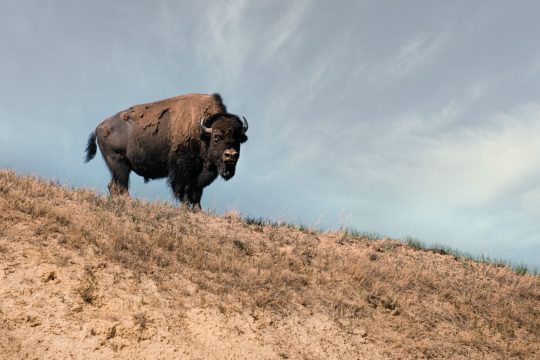
From 1960 to 2016, Eurasian beaver (Castor fiber) populations have ballooned 167-fold, from just a few thousand at the start of the 20th century to over 1.2 million wild beavers today. Grey seal populations have also grown by 6,273 percent and the population of Alpine ibex has risen by 417 percent. Eurasian badger populations have doubled, while Eurasian otter populations have tripled.
While these impressive rates of recovery are not reflected across all of Europe’s 250 wild mammal species, they do provide some evidence-based hope that wild mammals can once again flourish across Europe’s diverse and varied landscapes with the right support and policies in place.
The big picture
... Over the last 50 years the fate of some wild mammals across Europe has shifted. Some populations have experienced a rapid and dramatic increase over the last half century, reversing millenia of decline and offering fresh hope that nature can recover – if it’s given the chance.
Brown bear numbers have risen by an average of 44 percent between 1960 and 2016, while the Iberian lynx has seen its population grow by 252 percent. Humpback whales have seen their numbers rise by 37 percent between 1986 to 2016, while the pine marten – a natural predator to the invasive grey squirrel – has seen its population grow by 21 percent from 1986 to 2016. Some reptile species, such as the loggerhead turtle, have seen its numbers grow by 68 percent over the last 40 years.
The most impressive bounce backs, however, are among the beaver and bison – two species that play vital roles within ecosystems. Both beaver and bison populations have seen 167-fold increases over the last 50 years. These mammals help support a rich mosaic of habitats and biodiversity. Wild bison, for instance, trample and wallow in the soil and sand to create niche habitats for plants, insects and lizards, while also playing an important role in the dispersal of seeds.
Context and background
The impressive recovery rates over the past 50 years have been possible due to a shifting cultural and economic context. Alongside this, there is a growing scientific consensus of the importance of small and large mammals for sustaining biodiversity and helping ecosystems flourish. The sheer diversity of mammals, both in terms of their morphology and their roles within ecosystems, is testimony to the functions they perform. From the tiny bumblebee bat, which weighs just two grams, to behemoth blue whales, weighing in at 150,000 kilograms, mammals really do come in all shapes and sizes.
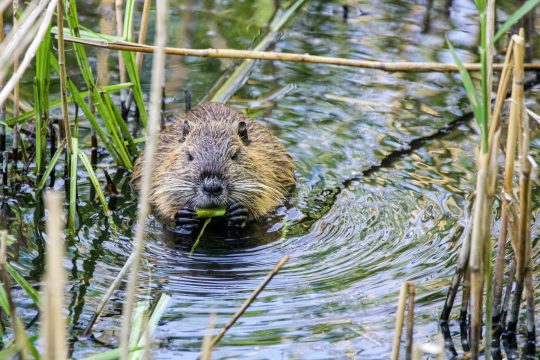
Wild mammals play a variety of leading roles within an ecosystem, from dispersing seeds, pollinating plants and regulating insect populations, to reducing disease transmission and creating niche habitats for other species. The European bison reintroduced to Kent in the UK have already started clearing paths through undergrowth, ripping the bark off trees, and wallowing around in the mud to make space for seeds and other habitats – natural processes that humans would struggle to replicate. Bison and other large herbivores are often labelled ‘ecosystem engineers’ for this very reason – they shape and manage the land they reside on.
Some species of mammals – such as the magical beaver – are considered keystone species due to their ability to shape the ecosystems around them, creating entirely new habitats through building dams where fish, birds and all manner of species can thrive. Other mammals, like bats, act as indicators of healthy and functioning ecosystems. Between 1974 and 2016, Geoffroy’s bat populations have increased 53-fold across Europe.
Wild mammals also have a role to play in reducing the damage and destruction wrought by climate breakdown. In the temperate climate of Europe, large mammals have been proven to reduce the risk of forest and wildfires by creating gaps in vegetation through grazing and trampling. In the summer of 2022, wildfires ravaged Europe, burning the second-largest area on record. As global temperatures continue to rise, wildfires will increase in their frequency and severity. Bolstering the population of large mammals could provide a useful tool in the fight against fires alongside deep and immediate cuts to emissions...
What’s more, the grazing of wild mammals can also help retain the carbon stability of soil over long periods of time. Soil contains vast amounts of carbon – more than all plants and the atmosphere combined – which makes ensuring its stability important for both climate efforts and environmental conservation. Mammals like the alpine ibex, which have seen their numbers grow by 417 percent from 1975 to 2016, are highly effective at stabilising soil carbon within grazing ecosystems.
-via Rapid Transition Alliance, March 29, 2023
#beaver#bison#mammal#ecosystem#ecology#endangered species#europe#united kingdom#kent#wildfires#rewilding#ecosystem restoration#good news#hope#hope posting
2K notes
·
View notes
Text
My Hero Academia: Otheon Headcanons
So I'm having fun speculating on the culture, history, and geography of Otheon and Klayd. Because it was 2am when I started writing this and I had nothing better to do, so here's an analysis no one asked for.
Otheon and Klayd are two nations that share an island located between Ireland and the Iberian Peninsula of Europe. The island is slightly bigger than Ireland and based on its location...well, anybody who's looked at a map knows there's no land mass that big there. Everything else in the series indicates My Hero is our world if people spontaneously started getting superpowers set in the near future of early to mid-2100s.
The simplest explanation available is we're just looking at an alternate universe where there is a large island in the Celtic Sea.
Or!
New islands are created naturally a variety of ways.
Volcanic activity
Glacial retreat
Growth from ocean sandbars
Sediment from river deltas
But these processes take longer than a hundred years, and sometimes new islands aren't even permanent. Hawaii was formed via volcanic activity over the course of millions of years. Ireland (formed by tectonic plate movement) is also four times the size of Hawaii, so it's highly unlikely the larger Otheon/Klayd island formed and grew to its size naturally.
...
My headcanon is in the early days of Quirks, a bunch of guys with lava-Quirks and other geology-related powers got high and created it for no reason other than just to see if they could do it. Because humans are really determined to do pointless shit sometimes.
"Yo, what if we just created a fuckin' island, bro! Let's gooo!"
Alternatively, a villain with a similar Quirk could have created the island for the purposes of having a really conspicuous lair.
"How did you discover my secret lair?"
"It's the size of Ireland, dumbass!"
Assuming the Otheon/Klayd island is manmade (and created by one or more persons acting independently of any existing nation), it's location makes things interesting.

Here's Otheon/Klayd's location.
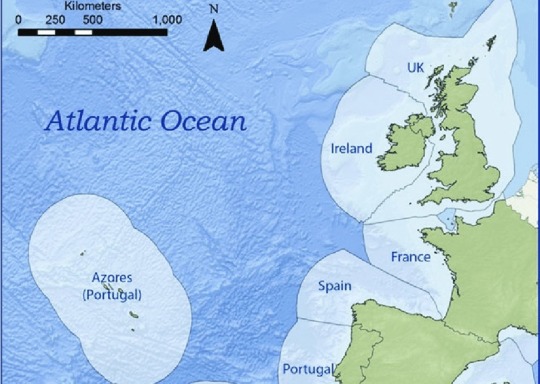
And here's an approximate map of the maritime waters of western Europe. (Approximate because I pulled this off of Google images and have no idea how accurate it is.) As you can see, Otheon/Klayd could be just far enough away from everyone else or just enough in everyone's space that there can be no obvious claim.
Because you know Spain, Portugal, the UK, Ireland, and France all probably did what nations do best: Took one look and the new spit of land and said, "Hey. That's ours."

If we do an overlay of the map, and allow some liberty under the assumption the animation team did not draw the European map 100% perfectly accurate or the boundary was changed by My Hero's 22nd Century, Otheon and Klayd's shared border could be an extension of the Irish/UK maritime border.
Since we know the Trigger bomb was in Rody's home city, we can tell the larger northwestern country is Klayd and the smaller southeast one is Otheon. Taking into account the maritime border, it'd be interesting if Klayd was or still is an Irish territory.
So who claimed Otheon?


Otheon's main city seems to be based on Lisbon, so I guess Portugal won that debate on who got Otheon? And built an identical bridge? I don't know. Admittedly the bridge is not concrete evidence, but based on the architecture, there is definitely a Spanish/Portuguese/general Mediterranean influence. And French. So one of those nations could claimed Otheon based on proximity.
But Otheon and Klayd appear to be independent nations, not part of anyone else. So now I'm imagining some country colonized an uninhabited new island only for those colonists to say, "Nope," and declared independence in under a hundred years.

But setting everything I've written above aside because it all is just wild speculation, the headcanon that I like the most regarding Otheon is the island was created by some hero or group of heroes during the early days of Quirks and it started off as a refuge/ceasefire zone for civilians hoping to escape the chaos of the new reality. Especially since Quirkless people were more common in those days, seeking shelter in a world where people are starting to have powers that can range from a minor inconvenience to god-like destruction would have been a dire need. As a result, the Quirkless population of Otheon and Klayd is much higher compared to other nations.
After society got itself re-stabilized, the island was officially established as a new territory with its two independent nations.

Also, Deku and Rody are probably speaking English with each other, but headcanon that Rody is bilingual or trilingual and was consistently muttering irritably in Portuguese or something whenever Deku did something to annoy him.
36 notes
·
View notes
Note
hi :D can you make me an icon/s of an iberian lynx, vancouver island sea wolf, a starfleshcore dog or a clouded leopard cub? also would i be able to use them as pfps? (w/ credits ofc)




Augh I’m sorry it took me so long to get these posted, I got jumpscared with a bunch of school stuff and was incredibly busy for a while :P The starflesh dog was really interesting to do, I’d never heard of the starfleshcore aesthetic before this ask and got to go down a fun little rabbithole while looking for pictures! There were a ton of different varieties of starflesh dogs that I found, but I went with this picture because the dog’s silly lil grin stood out to me lol
You can absolutely use these edits as pfps with credit! If it’s on Tumblr, just put my username or @ me on your intro post, whatever you’re comfortable with, and on other sites I’d appreciate if you could mention that I’m on Tumblr alongside my username when you give credit!!
(all images are free to use with credit; my askbox is open for requests for therian/alterhuman icon edits, moodboards, sketches, etc.!!)
#lynx therian#wolf therian#iberian lynx#vancouver sea wolf#clouded leopard#starflesh dog#feline therian#canine therian#therian#therianthropy#therian community#alterhuman#alterhumanity#alterhuman community#therian art#alterhuman art#hound draws
32 notes
·
View notes
Text
Wish Rewrite Fandom! Question!
@annymation @signed-sapphire @kstarsarts @wings-of-sapphire @oh-shtars @uva124 @rascalentertainments @emptyblog7 @spectator-zee @flicklikesstuff @chillwildwave @thisnameisnotspokenfor @peapeapeapa @gracebeth3604 @emillyverse @your-ne1ghbor
So our Starboys have seen much of the world beyond the Iberian Peninsula, right? Meaning that they saw a variety of animals from a variety of places.
How would they explain these animals?
Imagine the confusion on Asha's face as Starboy shows her an exotic animal, but also needing to explain where it came from. The hilarity of a Starboy trying to figure out how to explain a bizarre beast from countries that Spain doesn't know about yet.
Like this-
Altan, explaining what the North American bison is

Asha, who's never heard of the Americas

But tell me, how would your Starboy explain an animal from wasn't documented to Asha?
#starboy funnies#shapeshifting helps but that won't stop Asha from being scared#unless they turn into a platypus#that would be confusing and hilarious#asha and star boy#star boy#star boy troubles
39 notes
·
View notes
Text
Flowers of Mythology - Narcissus
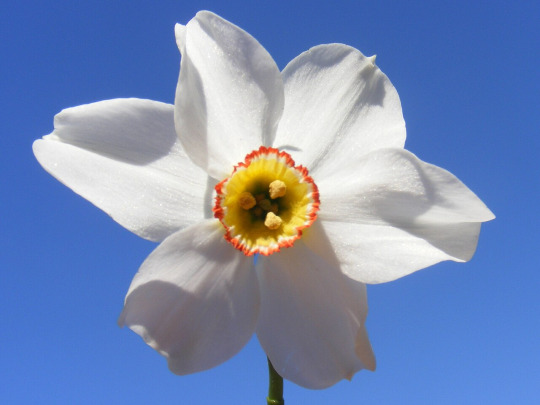
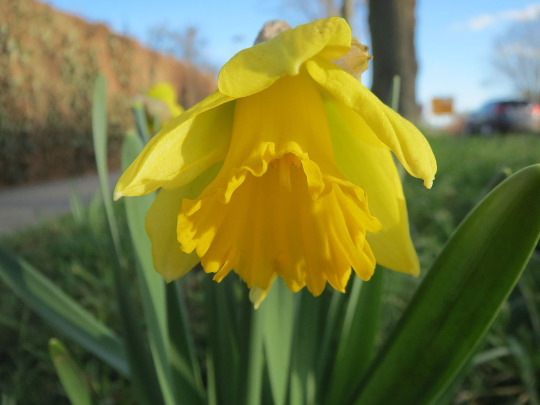
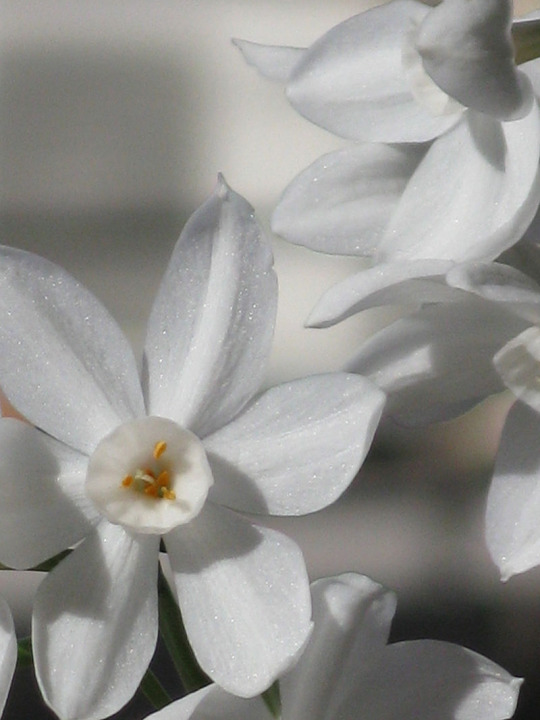
Narcissus is a genus of plants that include daffodil and jonquil as well as narcissus. They are spring flowering perennial plants that have obvious flowers with six outer petals and a cup- or trumpet-shaped crown. These can be white or yellow and both the outer petals and crown can be the same or opposite colors. Garden varieties, which are specifically bred for other colors, can come in orange or pink. They developed approximately 20 million years ago in the area around the Iberian Peninsula. It is native to southern European and North African meadows and woods, but was cultivated elsewhere so that it reached the Far east before the 10th century. It was used for treatment of cancer and uterine tumors, as attested by Hippocrates (lived around 460-370 BCE) and possibly the Bible as the Rose of Sharon, though that usage fell out of favor as attested by Pedanius Dioscorides (lived around 40-90 CE) and Soranus of Ephesus (lived 98-138 CE). There are compounds that do help protect against the growth of tumors. Pliny the Elder (lived 23-79 AD) was an advocate for topical usage. They also repel rodents. Modern usage of narcissus include as a treatment for Alzheimer's disease.
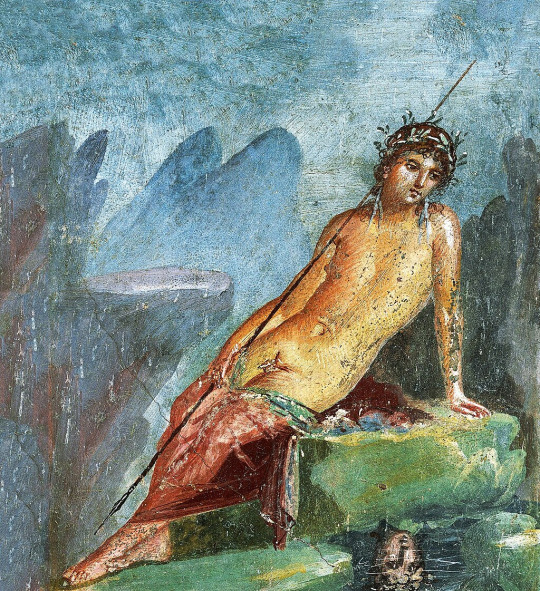
By Unknown author - http://almacendeclasicas.blogspot.com/2015/05/pompeya-la-casa-de-marco-lucrecio.html, CC0, https://commons.wikimedia.org/w/index.php?curid=112691977
The Greeks have two myths that involve the narcissus flower. One is That of the hunter Narcissus from Thespia in central Greek. The -issos ending of his names indicates that this myth likely pre-dates the Greek world, though whether the flower was named first or after the hunter is unknown. There are several versions of the myth that survive to this day. The most well known version of the myth of Echo and Narcissus is from Ovid's Metamorphoses. In that version of the myth, Tiresias, a prophet who took Zeus' side in a contest between him and Hera, so Hera blinded him. Zeus then made Tiresias a prophet. He also spent seven years as a woman, again caused by Hera for his hitting mating snakes with a stick.
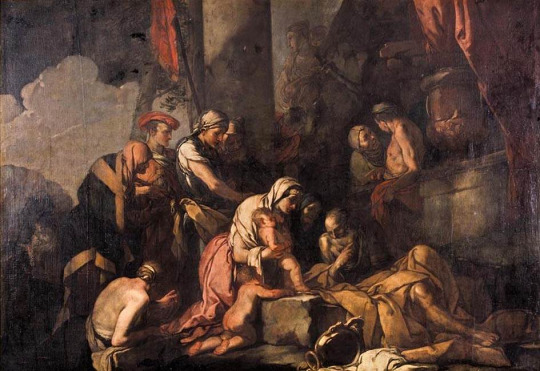
By Giulio Carpioni - Web Gallery of Art: Image Info about artwork, Public Domain, https://commons.wikimedia.org/w/index.php?curid=10618028
Liriope was 'ravaged' by Caphissus, a river god, and later gave birth to Narcissus, who was 'beautiful even as a child'. Tiresias prophesied Narcissus could only live a long life if he never 'came to know himself'. When he was 16, he went hunting with friends, and ended up separated from them and lost.
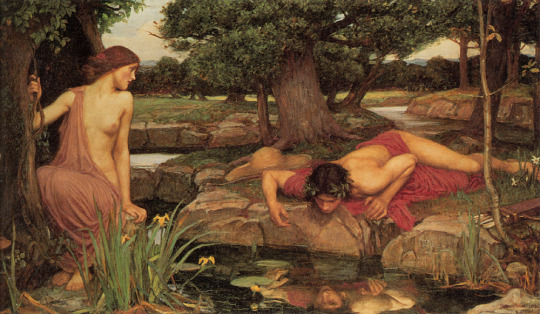
By John William Waterhouse - http://www.allartpainting.com/echo-and-narcissus-p-16444.html, Public Domain, https://commons.wikimedia.org/w/index.php?curid=7716057
Echo, a mountain nymph, was used by Zeus to keep Hera busy while Zeus catted about behind her back, or while his lovers escaped from Olympus. Hera punished her by making it so Echo could only repeat what she'd just heard. Echo saw Narcissus and became inflamed with desire and followed after him. Narcissus became aware of Echo's presence, but he couldn't see her. He called out 'Who's there?', which she called back, and so on. Echo crept closer to Narcissus, until he could see her. She tried to embrace him and he rebuffed her, telling her to 'keep her chains'. After this, Echo wasted away until only her voice remained.
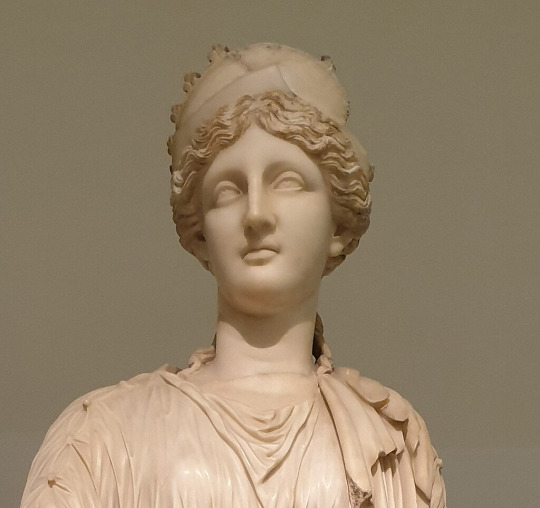
By Jamie Heath - https://www.flickr.com/photos/mumblerjamie/49345495687/in/photolist-7dQTrU-Jt9nya-6hGRqg-2ibuyGp-KnkmSu-2iUBjfG, CC BY-SA 2.0, https://commons.wikimedia.org/w/index.php?curid=138436541
Meanwhile, Nemesis, goddess of personal retribution, heard the prayers of Ameinias, a man who had also fallen in lust for Narcissus, but was likewise rebuffed. She proclaimed that Narcissus would 'never be able to be loved by the one he fell in love with.'

By Caravaggio - Self-scanned, Public Domain, https://commons.wikimedia.org/w/index.php?curid=25450745
Narcissus, wandering in the forest, becomes thirsty and approaches a pool of water that according to Ovid, no animal had ever approached. He leans down to get a drink and in the still water, he sees his reflection, one that he likens to a marble statue. He falls in love with his reflection, fulfilling both Tiresias' prophecy and Nemesis' curse in one moment. Narcissus eventually melted from the flames of his passion, becoming a gold and white flower with a bent head.
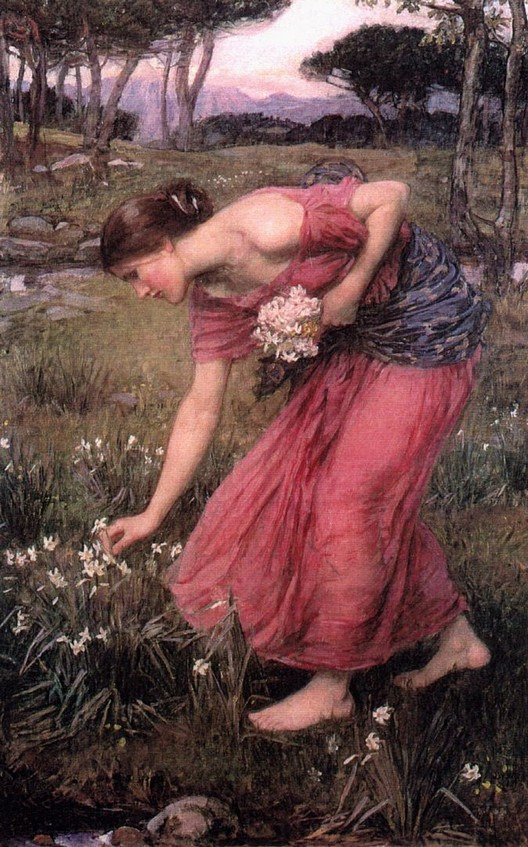
By John William Waterhouse - http://www.jwwaterhouse.com/paintings/images/waterhouse_narcissus.jpg, Public Domain, https://commons.wikimedia.org/w/index.php?curid=8034986
The second myth involves the capture of Persephone by Hades while picking narcissus flowers. Because of this, they're held sacred to Persephone and Hades and they're thought to grow along the River Styx.
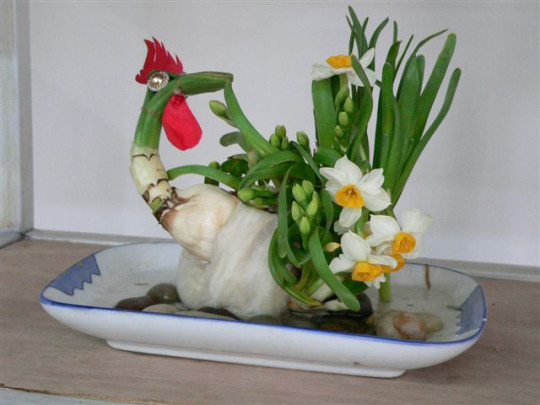
By Original uploader was 用心阁 at zh.wikipedia - Transferred from zh.wikipedia; transferred to Commons by User:Shizhao using CommonsHelper., CC BY-SA 3.0, https://commons.wikimedia.org/w/index.php?curid=12462572
Among the Chinese, narcissus is connected to the Chinese New Year and symbolizes good luck, in contrast to the association with death in many Western cultures.
7 notes
·
View notes
Text
gobbledegook and notes on goblins (part 1 of 2)
So I have a google doc full of HP goblin lore that I developed for a fic and then never really ended up using most of it rip. But I thought it would be interesting to share, in case anyone needs to include a line of Gobbledegook in their own writing or something! I know next to nothing about linguistics so I'm sure from that perspective it's probably full of errors but anyway, I had fun.
PART ONE: GOBLIN LANGUAGE
BASIC INFO:
Gravakeluk, or Gobbledegook (a human bastardisation) is the standard language used by most of the goblin population worldwide. (more on this in part 2)
The language is based heavily on compound words— short sounds can be interpreted in a variety of ways to transmit a specific meaning.
For instance, the only word we're given in canon is 'bladvak,' meaning pickaxe. This can be broken down into "blad" (blood, ore) + "vak" (axe), so "bladvak" is translated as "ore axe." "Blad" + "vak" + "den" (carrier/wielder) means "miner" or, literally, "pickaxe-carrier."
For a more complex example, "Rravk" can be translated as "sword" but also "power/might." The word Vvargdenrravkrak is broken down as: "Vvarg" (wand) + "den" (carrier) + "rravk" (power) + "rak" (place), and means Ministry of Magic. Literally, "wand carrier power place."
Pronunciation: Gobbledegook sounds harsh and aggressive to many humans. The language is guttural and consonants are created from the back of the throat, producing a rasping effect that almost sounds like the words are being spat at you. This is just how Goblins talk, however, and many phrases that were not intended as especially aggressive have been interpreted as such over the years by wizards.
Writing: Goblins use a runic semi-syllabic script— partially behaving as a syllabary and as an alphabet, similar to Paleohispanic scripts from the Iberian peninsula. Some characters represent syllables, while others represent specific phonemes. https://en.wikipedia.org/wiki/Semi-syllabary

A note— “uk” is often spelt “ook” by wizards, but there is no distinction in Gobbledegook, as there is one character for the sound “uk”. This is why something like Griphuk is often spelt as Griphook in English.
GLOSSARY:
Ak – The, or A. Usually to give importance or emphasis to the subject at hand, as it’s not grammatically necessary. “Ak Varld Vvargden” is a well-known publication that translates to “A World of Wizards”
-ak – a pluralising suffix. This is only used for certain words as many nouns (such as the words for goblin or wizard) can be used both as a plural and a singular noun. Rravk (sword) becomes Rravkak (swords). Since the “ak” sound is so common in the goblin language, it can sometimes be tricky for the untrained ear to distinguish it as a plural, an ability that is gained with time and familiarity.
Blad – ore, blood (ore is analogous blood in goblin culture)
Bladrak - mine, literally “ore place”
Bladvak – pickaxe (ore axe)
Bladvakden – miner, literally "pickaxe carrier"
Braz – whereupon, or “and then.” Used frequently to describe a connected sequence of events, where in English “and” might simply be used. “I went to the bank whereupon I took out a loan.”
Brun – bronze
-den – suffix meaning "carrier" or “wielder of”. For instance, bladvakden means “pickaxe carrier” or “miner”. More famously, “Vvargden” meaning wizard, translates literally as “wand-carrier”
Ek – on, in
Eluk – tongue, language
Eskarr – thank you. Humans don’t typically hear this word.
Euskaldunak – the Basque people (see Vvargdeneluk below)
Fell – city
Gorak – loan/transaction (Goblins view the sale of any items to wizards as the object simply being on loan, but really belonging to its makers.)
Gra – people, often used to mean goblins in general, “the people”. Not used for non-goblin people.
Grauld – Elder, member or members of the Council of Elders.
Gravak – Goblin
Gravakeluk- the goblin tongue, once misinterpreted rather carelessly and condescendingly by wizards as “gobbledegook,” which then stuck and simply became the English word for the goblin language.
Gravakrak – Goblin place, anywhere goblins dwell or control
Gu – our, us, we
Ka – I, mine, my
Kagra – return
Kavktta – death/die
Kuld – gold/money
Kuldden - banker (literally “gold carrier”)
Kuldrak – bank (literally “gold place”)
Leshak – liberation, freedom
Nad – nothing
Nadden - Muggle, literally “nothing-carrier”
Rak – place. Can be added as a suffix to mean “place of”, as in “kuldrak” (gold place, bank)
Rifa – silver
Rrantz – foul, rancid
Rravk – sword, might/power
Shor – hammer
Shorden – smith, “hammer carrier”, artisan
Shorrak - forge, literally “hammer place”
Uld – old
Vak – axe
Varld - world
Vvarg – wand
Vvargden – “wand-carrier”, or wizard.
Vvargdeneluk – any language spoken by humans. In general Goblins believe it is not worth differentiating between them. In the case of British goblins, English is only spoken by the few goblins who have regular dealings with wizards. The only known exception are goblins living in the Basque Country, who have assimilated words from Euskera (the Basque language) into their own parlance. Some of these words have even filtered over time into Standard Gobbledegook. In general, goblins like the sound of Basque and some wizarding historians theorise that Basque wizards and goblins once enjoyed a better relationship than in other parts of the world. Therefore, there does exist a word for this particular human language:
Euskaldunakeluk – the Basque language
Vvargdenrak – anywhere inhabited or controlled by wizards, literally “wizard place”
Vvargdenrravkrak – The Ministry of Magic, literally "wizard power place"
-----------------------
Example sentence:
English: “Return our swords to us, foul wizards, and then die upon them” Gobbledegook: “Gu Rravkak kagra, rrantz vvargden, braz kavktta ek.” Literal translation: “Our swords return(to), rancid wand-carrier, whereupon die on(it).”
part two here, covering goblin naming conventions and some notes on goblin society. I also talked a bit about gender in goblin society in this reply.
#gobbledegook#hp meta#meta#goblins#the entire goblin plot was based on ONE line from ootp lol. and i went insane about it and created this#in this next part there's a subplot about house-elves so im also developing a bit of house elf lore haha#and rip to my merpeople lore which got scrapped#long post
13 notes
·
View notes
Text
A compendium of references to Portugal in Japanese video games
The beginning of the historical relations between Portugal and Japan dates to the year 1541, when a Portuguese ship washed ashore at Jingujiura. Nearly sixty Japanese words are of Portuguese origin. A variety of Japanese traditions and culinary delights were introduced by Portuguese traders, sailors and missionaries. But in what way has this cultural exchange extended to the more recent phenomenon of Japanese digital games? As a portuguese devotee of Japanese culture, the topic seemed relevant enough to merit some additional exploration.
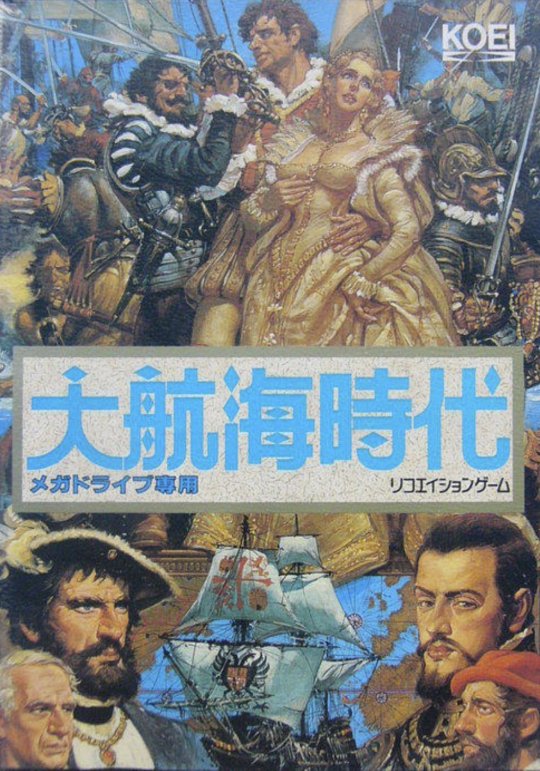

To my knowledge, the first significant reference to Portugal in Japanese video game is found in Koei's The Age of Discovery from 1990, a game published in the west under the title Uncharted Waters. The main character is a disgraced Portuguese nobleman named Leon Ferrero who resorts to maritime exploration, trade and naval warfare to restore his family's good name and prestige.

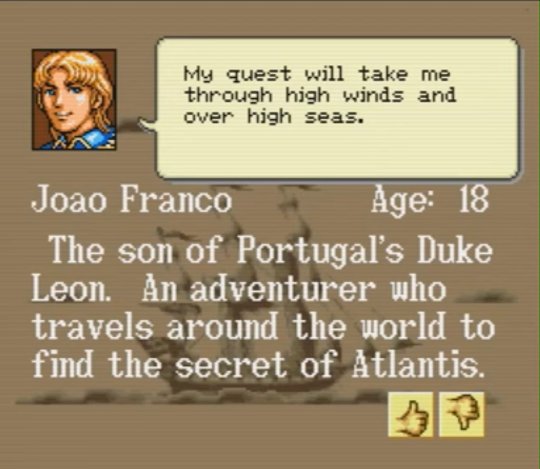
Its 1993 sequel, known in the west as New Horizons, diversifies the base game structure of the original by including multiple characters to select from, each with their own story and mission. Among them is the tale of João Franco, the son of the original episode's protagonist Leon, who sets out to discover the mysterious location of the fabled Atlantis, no less.
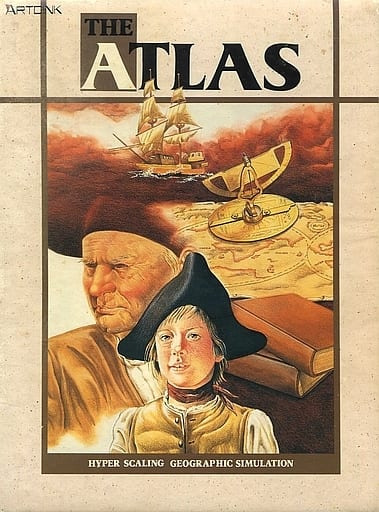
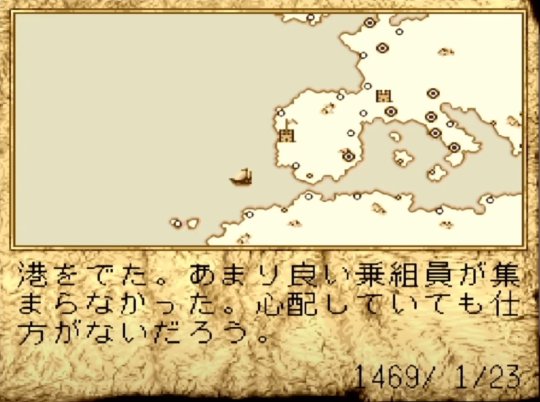
Another meaningful reference can be found a year later in ArtDink's 1991 strategy game The Atlas, in which the player takes on the role of a 15th century explorer with a five year contract with the King of Portugal to discover and chart lands around the Iberian Peninsula.
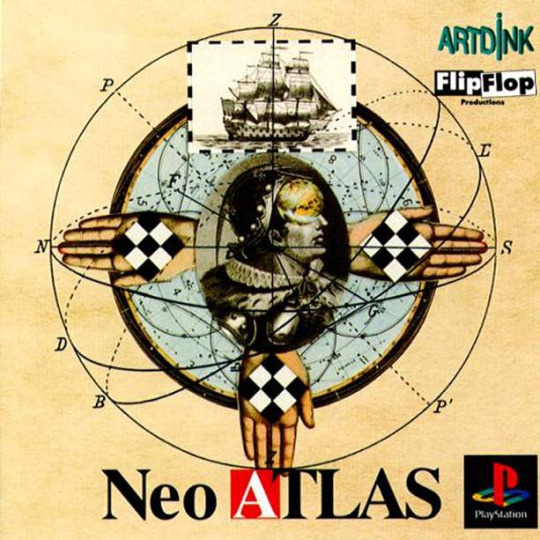
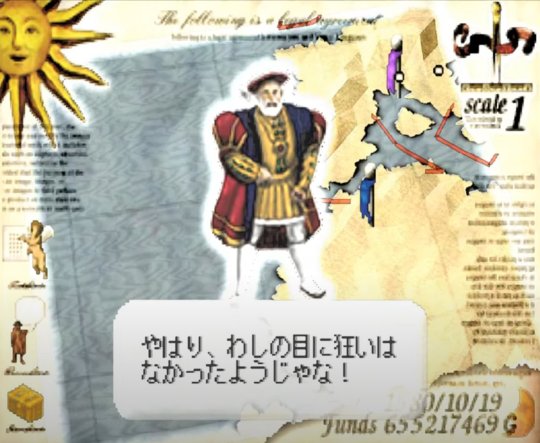
In 1998, ArtDink recreated the game for contemporary systems and published as Neo Atlas. The protagonist is a Portuguese trading company owner seeking business expansion opportunities in remote territories, as well as discover and chart hitherto unknown parts of the globe. A similar premise is found in a later sequel, Neo Atlas III.
Apart from nautical strategy games, a few other titles exist where mentions to the Portuguese territory, language and culture can be traced.
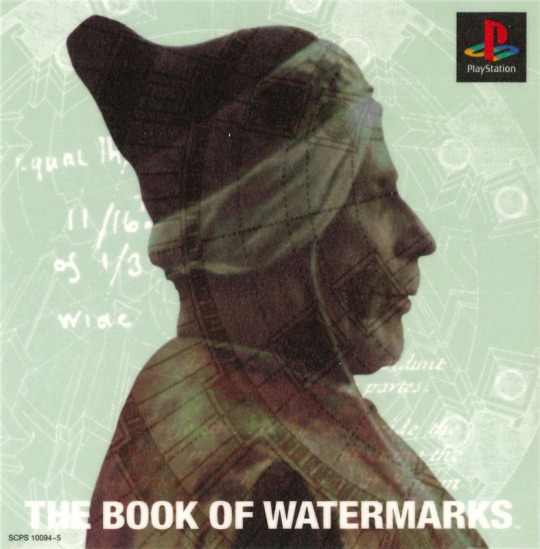
Galvanized by the success of Cyan's world-renowned point and click adventure CD-ROMs, Sony Computer Entertainment helped to publish The Book of Watermarks, a game designed by a miniscule Tokyo-based studio named Watermarks that is brimming with interesting first and second-hand references to Shakespeare's The Tempest. The objective of this visually impressive pre-rendered journey is to aid in the recovery of a series of ancient tomes, each including the nuclear bases of knowledge for mankind.
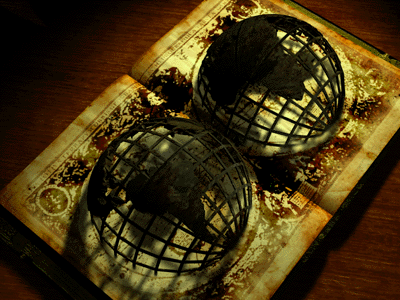
The very first lost volume is named the Book of Navigators, said to be owned by the historical Infante Dom Henrique from the 15th century, condensing information on shipbuilding, oceanography, geography and astronomy. While a purely fictitious book, the reference to Prince Henry is historically accurate, him being a pivotal figure in the early age of Portuguese maritime discoveries, the governor of the Order of Christ who at once built and ruined his reputation through his various campaigns in the African continent.

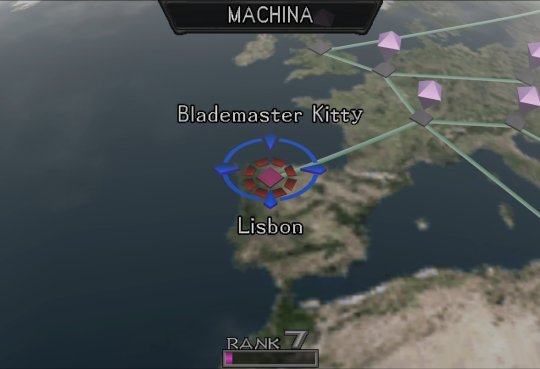

Atlus' futuristic vision of Earth in Maken X includes a most unexpected tour of Europe, with a mandatory stop in Lisbon. Inexplicably, the developers got its geographic location wrong and moved to all the way to the northern Spanish region of Léon. The level, itself, boasts a reasonably accurate depiction of one of the city's oldest quarters, Alfama, and the architectural styles found therein.


Although I could not discern any actual references in the game itself, the Grandia II soundtrack by the veteran composer Noriyuki Iwadare contains two themes whose lyrics are written in Portuguese: A Deus, a double-entendre that can be translated to both farewell and to God; and Canção do Povo, meaning People's Song. Also, the name of the official soundtrack is named Melodia, which translates to Melody as you'd expect. Both themes were performed by guest singer Kaori Kawasumi, who took on the composer's challenge to sing them despite her not knowing the language.
She was coached and assisted by José Álvarez and Motoi Sato from the Portuguese Arts and Culture Center in Japan, whom she thanks in the acknowledgement section. The Grandia II Special Package edition booklet contains a page with two photos of Portugal, one for the Jéronimos Monastery in Lisbon and the other, seemingly, for the Moorish Castle in the nearby town of Sintra.
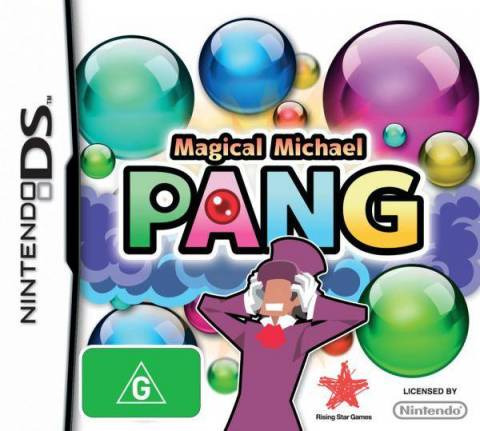

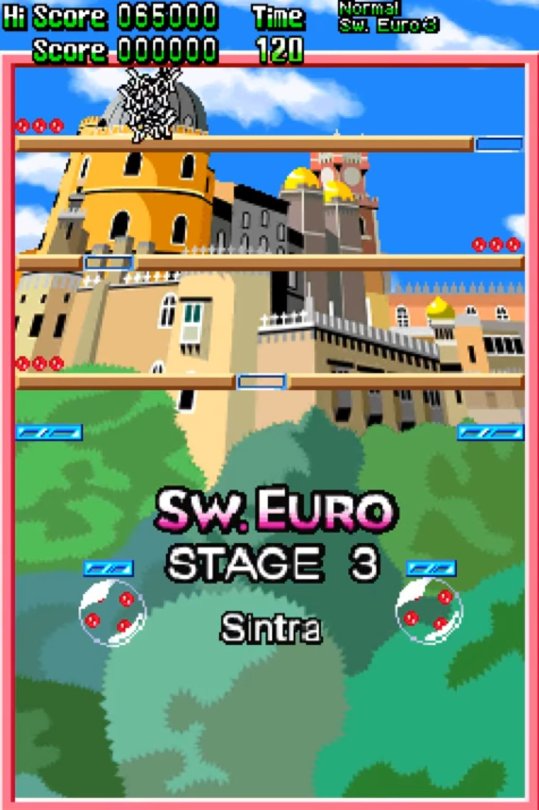
The last Pomping World (a.ka. Buster Bros/Pang) that Mitchell Corporation ever produced before shutting down was the 2010 DS European exclusive Magical Michael. It includes two levels set in Portugal, one in Lisbon by the Belém tower, a nautical landmark, and the other in the Sintra National Palace. Their representation is at once pleasingly stylized and true to life.

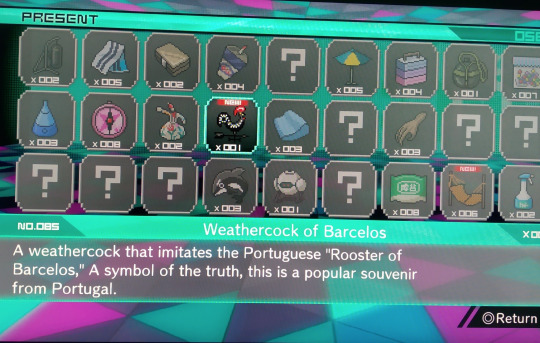
This final reference is found in Spike Chunsoft's third installment of their successful visual novel series, Nyūdanganronpa V3 Minna No Koroshiai Shin Gakki. Among the dozens of MonoMono machine items that can be acquired, one is a weathercock styled after a traditional Portuguese folktale hero, the Galo de Barcelos, meaning the rooster of Barcelos, a town in Northern Portugal.
As per the description, this animal became famous through an age-old tale involving a man wrongly sentenced to death who seconds before his execution remarked he was as certain to be innocent as it was certain that a nearby rooster would sing. Because the bird did crow, much to everyone's amazement, he was exonerated. Thus, the black rooster became a symbol for truth.
I would like to thank @diogojira and @DanielOlimac for their assistance in making this article possible.
#Japanese history#Portugal#culture#tradition#japanese videogames#portuguese references in japanese video games#Uncharted waters#the atlas#neo atlas#maken X#pang#magical michael#grandia II#koei#atlus#game arts#mitchell corporation#spike chunsoft#artdink#lisbon#alfama#Noriyuki Iwadare#kaori kawasume#sintra#book of watermarks
51 notes
·
View notes
Note
OH MY GODS FINALLY I HAVE AN EXCUSE TO TALK ABOUT WISH’S TIME PERIOD I AM HAPPY TO GIVE YOU FOODS FOR THAT ANONS ASK YES
Okay! So we know that with a simple Google search that Rosas located in the Mediterranean Sea off the Iberian Peninsula which contains the bulk of Portugal and Spain, the entirety of Andorra a small part of the French department of Pyrénées-Orientales, and the British Overseas Territory of Gibraltar.
From this knowledge we can cross reference the buildings in those areas through different time periods with the look of the buildings in wish. But Rosas hasn’t just been built it’s been going for at least 17 years, so we’ll only cross reference the castle as that was likely the first building built.
It seems similar to two buildings, the Alhambra which was built in 1238 so right at the end of the Middle Ages which lasted 500 to 1400-1500 ce. So bingo! We have our time frame! It’s anywhere after 1238!
So what were the foods in the Mediterranean like after 1238? Fishy! Literally. They ate large amounts of fish and other seafood. There were many types of soups and stews and salads were popular. They liked a variety of cheeses, and fruits were eaten both fresh or cooked. Fruits included apples, melons, dates, figs, grapes and pomegranates.
Almonds, walnuts and pistachios were used in many dishes as well as being eaten by themselves. They ate all kinds of meats including pork and numerous types of fowl.
Thank you for reading my essay that was meant to be one paragraph but quickly derailed. Don’t know if this is me being helpful or really annoying, I’m sorry if it’s the second one. Hope this helps, and personally I think Magnifico’s favourite food would either be:
• Fruits - like pomegranates and melon
• Meat - I also get those vibes from him weirdly enough
• It’s a wheel spin - He’ll eat anything and can’t pick a favourite. He’ll even mix them together sometimes and has been accused of being pregnant once for mixing olive oil with pomegranates to which his ego was wrecked for the rest of the week.
that anon’s ask was like 5 days old when i answered it but i hope they see this
29 notes
·
View notes
Text
Phylogenetic wild cat tournament
Lynx lineage
Genus: Lynx
Depth: 9 (8 wins away from championship)
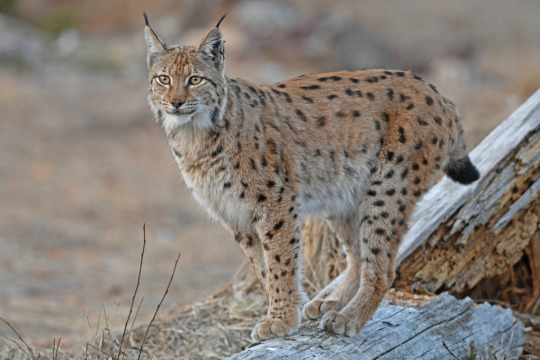
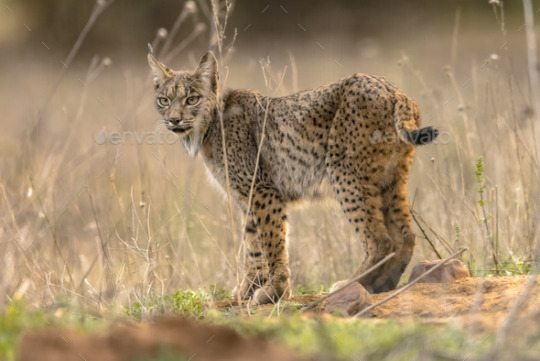
Lynxes! These are the eurasian species, both of their names give the right idea: the eurasian lynx lives wide across the continent while the iberian lynx is restricted only to the Iberian Peninsula.
An interesting thing about lynxes is that their patterns are quite variable: they can be spotted, rosetted or almost completely without markings, and these varieties exist within the species or even subspecies. I wrote a little about this here (including melanistic and albino lynxes).
Eurasian lynx

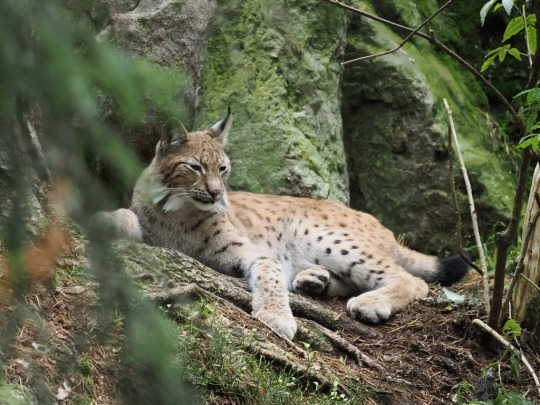
Iberian lynx

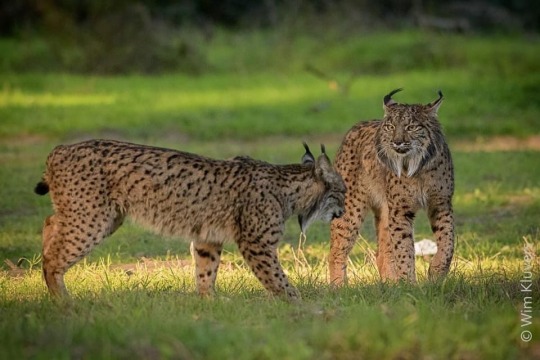
#polls#cats#tournament poll#phylogenetic wild cat tournament#lynx lineage#eurasian lynx#iberian lynx#compared to the other lynxes the iberian looks like. an emo warrior cat.
52 notes
·
View notes
Text
Unconquista: A Tale of Sephardic Conquest
A little while ago, I thought of firing up Crusader Kings 3 for another playthrough. It's been a little while since I've played. If you don't know, Crusader Kings 3 (CK3) is a grand strategy game about being a medieval lord and getting into Game of Thrones style escapades.
I have a fun tradition where I only play as Jewish rulers of one variety or another, and for this playthrough I decided I wanted to touch upon my Sephardi heritage and start in Iberia (Modern day Spain/Portugal.) The current goal is to see if I can hold on to power long enough to take the entire Iberian Peninsula under my control, and if I get there then maybe we'll go sack Rome for the Menorah and go re-establish the Kingdom of Israel. Here is my starting screen:

I've created a custom ruler and renamed the county I start with. My little head canon is that the Jewish population of this county got sick of pogroms and the war between the Christians and Muslims and have decided to seize control via a peasant's uprising. My ruler, Count Elazar is a pretty straightforward guy. He has decent stats in all aspects of ruling except for Intrigue, so I hope he doesn't get poisoned. I've taken the Generous and Just traits mostly to counteract the negatives of taking a martial focus for him, since I'm probably going to need to do a lot of fighting in the short term. However, I've also made him a Wise Man, a Theologian and a Gardener for the bonuses that'll give me to managing stress as well as helping to reap the benefits from religion.

Now this is fantastic, my wife (who was randomly generated) is a better strategist than I am! We love this representation of strong Jewish women. Anyway, I'm gonna get my inital affairs in order and then hit play. I'll post updates when major developments or funny shit occurs. (And I swear to Fucking G_d, if anyone tries to make this silly little historical fantasy into some political hill to die on I will block your ass so fast and send a dybbuk your way.)
#Jumblr#Crusader Kings 3#alt history#Unconquista#< that'll be my tag for updates for this#I hope that this stupid little playthrough brings my jumblr chaverim some joy and respite
16 notes
·
View notes
Text
Moth of the day #4
Green carpet
Colostygia pectinataria
From the geometridae family. They have a wingspan of 22-30mm. They can be found in a variety of different habitats, from gardens and hedgegrows to fens and moorlands. This species is found in the Iberian Peninsula and along western and central Europe.


#moth#moths#green carpet#green carpet moth#lepidopterology#lepidoptera#geometridae moth#geometridae#insect#nature#pretty moth
84 notes
·
View notes
Text
La Bola is a classic Madrid tavern. Located on a quiet backstreet, it is painted lacquer red on the outside, with a dark wood and colored tile interior. We arrived during a busy Sunday lunch service. The place was filled with multigenerational families and loud groups of friends who, like us, were there for the jewel of the crown, the most Madridian dish of all: Cocido madrileño, a stew that La Bola has perfected in its 150 years of operation.
Cocido madrileño (“the stew of Madrid” in Spanish) is a rustic dish of chickpeas, vegetables such as potatoes and cabbage, and a variety of pork cuts, sausages and marrow bones. At La Bola it is still cooked the traditional way, layered in individual clay pots over coal. The stew is served over two courses, making for a full meal. First, the busy waiter poured the cooking liquid out of the cocido pot into a soup bowl filled with vermicelli noodles, to be eaten like a soup. The chickpeas, vegetables and meats were placed on a platter for the main course (some serve the chickpeas for a second course and the meat with veggies for third). The scene repeated itself at almost every table in the packed restaurant, with guests watching in anticipation as the waiters laid out the cocido spread.
But as it turns out, the roots of this Madrid staple, this pork-laden stew, are deep in the medieval Sephardi community of Spain. Specifically, in a Shabbat overnight stew called adafina (AKA dafina, tfina and s’khina).
To understand the dish’s amazing evolution, we need to look way back.
Muslims conquered the Iberian Peninsula in the early eighth century. They brought religious moderation to Al Andalus, in addition to new dishes, spices, fruits and cooking techniques. Since Jews and Muslims both avoid pork, their cuisines at the time were very similar.
Cooking stews overnight, over or under coal, was a technique used by Muslims while still in the Levant. But in Al Andalus, it was the Jews who were most identified with this cooking method, mainly because it was a good practice for Shabbat, when lighting fire is not allowed. The word adafina comes from the Arabic word for “hidden” or “buried,” since the dish was cooked while buried under coal, though the dish is also known as ani or calinete (“hot” in Spanish) or hamin (“a warm dish” in Hebrew, a name that was used for Shabbat dishes in the Talmud).
Adafina, just like cocido madrileño, consists of chickpeas, vegetables, meat (lamb) with the occasional addition of hard-boiled eggs (huevos haminados) cooked together at a low temperature overnight. Adafina is still prepared by Tunisian and Moroccan Jews of Sephardi descent around the world. Through the years, more ingredients were added to the pot, most notably potatoes from the new world, as well as wheat berries, sometimes tied in a cloth, and a sweet loaf of ground beef.
According to author and food historian Claudia Roden, Moroccan adafina was served in several courses, first potatoes and eggs with plenty of the soup, then the wheat and/or rice and lastly the meat with chickpeas. Just like the cocido is served in Madrid today.
The first cookbook available to us from the Iberian Peninsula is the 13th century Andalusian “Kitab Al Tabikh.” It includes six Jewish recipes, and two of them use the technique of covering the pot with another pot of coal to keep it warm. A third recipe, described as “Stuffed, Buried Jewish Dish,” is called Madfūn, an Arabic word that comes from the same root as adafina, to bury. Although the recipe is different to what we know as adafina today, the method of cooking it for a long time under coal is the same.
With the expulsion of the Jews from Spain in 1492, many left to Portugal, North Africa and the Ottoman Empire, where for 500 years they kept their prayers, language (Judeo-Spanish or Ladino) and their unique cuisine, which is why adafina is present in Moroccan homes today.
Those who stayed in Spain were forced to convert to Catholicism. To enforce the sincere conversion and prevent the conversos (converts) from practicing their Judaism in secret, the monarchy used the Inquisition, an institution that kept its devastating work well into the 19th century.
One of the ways the Inquisition spied on and convicted heretic conversos was by observing their food. They published guides with detailed descriptions of Shabbat dishes, matzah on Passover, eggplant dishes and the avoidance of pork. Interestingly, the conversos themselves, having no other resource available, used those same lists in order to learn how to keep their Jewish customs alive. Neighbors and servants reported their suspicions to the Inquisition authorities. And so adafina became one of the most incriminating dishes, punishable by cruel execution.
A letter written by an eager informer to King Ferdinand in 1516 says that “nearly all the residents of this city [Seville] smell Jews, them, their houses and the doors of their houses, because they are gluttons and pigs, and they nourish themselves with casseroles, garlic and adafinas,” as documented in Hélène Jawhara Piñer’s book “Jews, Food, and Spain.”
But if the roots of cocido madrileño are, in fact, in the Jewish Sephardi adafina, why is it full of pork?
While many conversos saw avoiding pork as the most important Jewish law to keep, others deliberately consumed pork in public in order to avoid any suspicion. “The conversos of Majorca were known as Xuetes (“xua” meaning “bacon” in Majorcan Catalan), explains Paul Freedman in his book “Why Food Matters.”
“Because their ancestors cooked and ate bacon in public to show their sincerity, but they only did this once or twice a year.”
“The one way to demonstrate that they [the conversos] now are Christian was to eat pork, so they introduced pork into the most famous dish they ate, adafina,” Mara Verdasco Arevalo, La Bola Tavern’s manager and owner, told me in an email.
For hundreds of years after the expulsion, Spain had no Jewish community and the Jewish roots of many staples of Spanish cuisine were all but forgotten. In recent years, Spain has been making an effort to revive its elaborate Jewish history. Spanish governments have worked to renew Jewish quarters around the country, began issuing Spanish passports to Sephardim and opened new Jewish museums. Hopefully a thorough research of Spain’s culinary heritage, acknowledging the Muslim and Jewish roots, will be part of it.
12 notes
·
View notes
Text
Africans teaching Europeans how to bathe 🤢

by Amani Sawari
on February 6, 2019
We often hear about Africans teaching Europeans how to bathe and the other hygienic rituals required in order to build a healthy society. Abu l-Hasan Ali Ibn Nafi, also known as Ziryab, was born in modern day Iran circa 789 CE to a freed Ethiopian slave. His nickname, Ziryab, means blackbird and was given to him in reference to his dark complexion and stunning singing voice. He is known as the innovator of those hygienic practices such as bathing, shaving and the use of toothpaste, perfumes, fragrant oils and deodorant. Moor was a term Europeans used to describe indigenous Africans and while many people may have heard of the term, Ziryab is not a name circulated in Western history and not many people understand the weight of his influence. During the 10th century these weren’t African leaders only contributions to European society.
Ziryab arrived in Cordoba, the Arabic Empire’s ‘Wild West’, in 822 CE. As a master musician, his musical talent dramatically increased his popularity in the region, introducing many of the earliest versions of several instruments, including the lute, guitar and the Lyre. He was so sought after for his musical talent that he later founded an influential music school in Cordoba, Spain translating Eastern ideas into Western European music. Though he was originally known for his musical skills, his influences weren’t restricted to the music realm. His contributions to music culture in Europe led to his becoming a respected leader that people looked to in many other areas of their lives.
Spanish occupation by the Moors began in 711 AD when an African army led by Tariq ibn-Ziyad from northern Africa invaded the Iberian peninsula. From then the Moors ruled Spain for 800 years allowing African royals and other leaders to influence many aspects of Spanish society. Ziryab was a natural born leader and pioneer. Along with reforming music Ziryab introduced a new style of eating in Western Europe, set course meal. The new eating style began with a soup that was followed by a fish course, then a meat course and finally a desert. This is an eating style that can still be seen in Western society today. He also recommended the use of crystal, as opposed to metal, to serve drinks. Ziryab expanded Europeans diet with the introduction of a variety of new crops including hard wheat, sugar, orange, lemon, peach, apricot, fig, sugar cane, dates, ginger, pomegranate saffron and rice. All of these continue to be prominent in Spain today. Instituting these new crops in the region required the Moors intimate knowledge of irrigation and cultivation. They also taught Europeans how to properly store spices for up to 100 years.
In addition to establishing new hygiene practices, founding a music school and introducing new crops in Spain, Ziryab was also considered a fashion icon at the time. Clothes became more than just modest coverings for the body as Ziryab used clothes as a form of adornment. He was unique in the way he would change his clothes according to the seasons and weather and even went as far as having different outfits throughout the day.
During the time that London had a largely illiterate population, unpaved streets with none of the technological advancement of the Roman empire that existed 600 years prior; the Moors advanced greatly in hydraulic engineering. During the 10th century the Moors had paved roads, street lighting, running water, hundreds of public baths, mosques and well stocked libraries. Because paper was needed in order to create documents to transfer knowledge the Moors also brought paper making to Spain, and under Moorish conquest the first paper mill is recorded at Xàtiva in 1151. Along with this, over 4,000 Arabic words and derived phrases were absorbed into the Spanish language. Spanish use of words like algebra, alcohol, chemistry, nadir, alkaline, cipher checkmate, influenza, typhoon, orange, and cable can be traced back to the Moors.
As we can see in the many examples presented, the Moors mastered several methods of survival that vastly contributed to European society from the 10th century into the 12th century. During this time the Moors introduced multiple new scientific techniques to Europe in astronomy, chemistry, physics, mathematics, geography and philosophy. While conquest came as a result of war, during the Moors’ reign, the people flourished in Moorish Spain with paved roads, universal education and efficient hospitals. Leadership requires the effective transfer of knowledge and the Moors successfully transferred several methods and techniques of their high functioning society to Europeans. These contributions continue to go unnoticed and ignored in Western public education. It’s essential that we circulate these stories in order to better understand our history through a proper lens that honors the work of our ancestors.
2 notes
·
View notes
Text

Kordofan melons from Sudan are the closest relatives and may be progenitors of modern, cultivated watermelons. Wild watermelon seeds were found in Uan Muhuggiag, a prehistoric site in Libya that dates to approximately 3500 BC. Watermelons were domesticated in north-east Africa, and cultivated in Egypt by 2000 BC, although they were not the sweet modern variety. Sweet dessert watermelons spread across the Mediterranean world during Roman times.
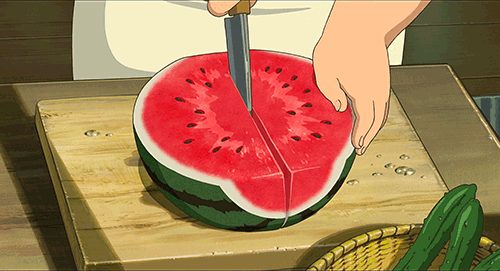
Many 5000-year-old wild watermelon seeds (C. lanatus) were discovered at Uan Muhuggiag, a prehistoric archaeological site located in southwestern Libya. This archaeobotanical discovery may support the possibility that the plant was more widely distributed in the past.
In the 7th century, watermelons were being cultivated in India, and by the 10th century had reached China. The Moors introduced the fruit into the Iberian Peninsula, and there is evidence of it being cultivated in Córdoba in 961 and also in Seville in 1158. It spread northwards through southern Europe, perhaps limited in its advance by summer temperatures being insufficient for good yields. The fruit had begun appearing in European herbals by 1600, and was widely planted in Europe in the 17th century as a minor garden crop.
Early watermelons were not sweet, but bitter, with yellowish-white flesh. They were also difficult to open. Through breeding, watermelons later tasted better and were easier to open.
European colonists and enslaved people from Africa introduced the watermelon to the New World. Spanish settlers were growing it in Florida in 1576. It was being grown in Massachusetts by 1629, and by 1650 was being cultivated in Peru, Brazil and Panama. Around the same time, Native Americans were cultivating the crop in the Mississippi valley and Florida. Watermelons were rapidly accepted in Hawaii and other Pacific islands when they were introduced there by explorers such as Captain James Cook. In the Civil War era United States, watermelons were commonly grown by free African people and became one symbol for the abolition of slavery. After the Civil War, African people were maligned for their association with watermelon. The sentiment evolved into a racist stereotype where Africn people shared a supposed voracious appetite for watermelon, a fruit long correlated with laziness and uncleanliness.
Seedless watermelons were initially developed in 1939 by Japanese scientists who were able to create seedless triploid hybrids which remained rare initially because they did not have sufficient disease resistance. Seedless watermelons became more popular in the 21st century, rising to nearly 85% of total watermelon sales in the United States in 2014

A melon from the Kordofan region of Sudan – the kordofan melon – may be the progenitor of the modern, domesticated watermelon. The kordofan melon shares with the domestic watermelon loss of the bitterness gene, while maintaining a sweet taste, unlike other wild African varieties from other regions, indicating a common origin, possibly cultivated in the Nile Valley by 4360 BP (before present)

#kemetic dreams#watermelon#wow#kordofan#sudan#ta seti#nubia#progenitor#nile valley#african#afrakan#africans#libya#north africa#african culture#north ifriqiya#ifriqiya#kordofan melon
27 notes
·
View notes